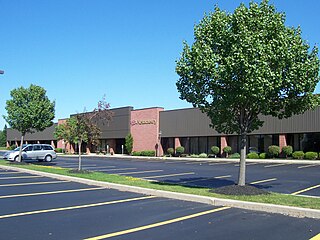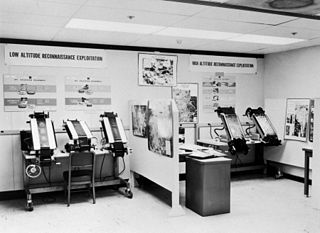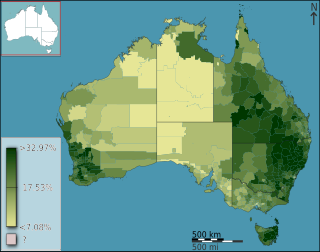
Aerial photography is the taking of photographs from an aircraft or other airborne platforms. When taking motion pictures, it is also known as aerial videography.
Aerial archaeology is the study of archaeological remains by examining them from a higher altitude. In present day, this is usually achieved by satellite images or through the use of drones.

Google Earth is a web and computer program that renders a 3D representation of Earth based primarily on satellite imagery. The program maps the Earth by superimposing satellite images, aerial photography, and GIS data onto a 3D globe, allowing users to see cities and landscapes from various angles. Users can explore the globe by entering addresses and coordinates, or by using a keyboard or mouse. The program can also be downloaded on a smartphone or tablet, using a touch screen or stylus to navigate. Users may use the program to add their own data using Keyhole Markup Language and upload them through various sources, such as forums or blogs. Google Earth is able to show various kinds of images overlaid on the surface of the Earth and is also a Web Map Service client. In 2019, Google revealed that Google Earth now covers more than 97 percent of the world, and has captured 10 million miles of Street View imagery.

Bing Maps is a web mapping service provided as a part of Microsoft's Bing suite of search engines and powered by the Bing Maps Platform framework which also support Bing Maps for Enterprise APIs and Azure Maps APIs. Since 2020, the map data is provided by TomTom, OpenStreetMap and others.

Pictometry International is an aerial measurement company based in Henrietta, New York that develops software that uses three-dimensional aerial photographs to view high-resolution images of buildings in their entirety. Pictometry International's technology was developed at the Rochester Institute of Technology and shows structures at an oblique angle or at a 45-degree angle, from all sides providing perspective and overhead shot images that are accurate to 1/100th of an inch. The company has 80 Cessnas that provide high-resolution aerial photography in counties that include 95 percent of the U.S. population.
Blom is a European service provider within acquisition, processing and modelling of geographical information. Blom maintains European databases with collections of map, images and models. With particular focus on online services, Blom provides data and services to customers in government, enterprise and consumer markets and enables partners to create applications using Blom’s databases, location-based services and navigation systems. Blom has more than 600 employees and subsidiaries in 10 countries. The company headquarters is in Oslo, Norway. The parent company NRC Group is listed on the Oslo Stock Exchange.

Google Street View is a technology featured in Google Maps and Google Earth that provides interactive panoramas from positions along many streets in the world. It was launched in 2007 in several cities in the United States, and has since expanded to include all of the country's major and minor cities, as well as the cities and rural areas of many other countries worldwide. Streets with Street View imagery available are shown as clickable blue lines on Google Maps.
ImageAmerica Aviation, Inc. is an aerial photography company that was acquired by Google in July 2007. The company specialized in creating aerial photos with "accuracy, quick delivery and low cost". It previously sold its services primarily to city, county, state, and federal governments and to corporate customers. ImageAmerica also made money by selling low-cost imagery to county appraisers and assessors. The company's clients include the Texas Department of Transportation, the U.S. Geological Survey, and the Lucas County office that covers Toledo, Ohio. For satellite imaging, the company charges US$99 per 1 square mile (2.6 km2), compared to other companies which could charge from $500 to $700 and for a lower quality than what ImageAmerica offers. It also developed its own DDP-2 camera system. The system is housed in an aircraft. It has the ability to capture details as small as 6 inches (150 mm) to 12 inches (300 mm). ImageAmerica's patented processing system has the ability to produce orthorectified imagery corrected for perspective distortions. The company's technology also uses sensors which are based on a unique design from Sarnoff Research Labs in Princeton, New Jersey.

Aerial photographic and satellite image interpretation, or just image interpretation when in context, is the act of examining photographic images, particularly airborne and spaceborne, to identify objects and judging their significance. This is commonly used in military aerial reconnaissance, using photographs taken from reconnaissance aircraft and reconnaissance satellites.
Cyclomedia is a Dutch company specialising in the large-scale and systematic visualisation of environments based on 360° panoramic photographs (Cycloramas). Using specialised technology, large public areas are photographed and stored in an online database. Overlapping panoramic images are captured at 5-meter intervals from public roads at street level, with the camera system mounted on a moving car.

Computer cartography is the art, science, and technology of making and using maps with a computer. This technology represents a paradigm shift in how maps are produced, but is still fundamentally a subset of traditional cartography. The primary function of this technology is to produce maps, including creation of accurate representations of a particular area such as, detailing major road arteries and other points of interest for navigation, and in the creation of thematic maps. Computer cartography is one of the main functions of geographic information systems (GIS), however, GIS is not necessary to facilitate computer cartography and has functions beyond just making maps. The first peer-reviewed publications on using computers to help in the cartographic process predate the introduction of full GIS by several years.
Intermap Technologies is a publicly traded company headquartered in Douglas County, Colorado, United States. Intermap provides geospatial solutions that allow GIS professionals in commercial and government organizations worldwide to build a broad range of applications. Industries such as energy, engineering, government, risk management, telecommunications, water resource management, and automotive use Intermap’s NEXTMap 3D terrain products and geospatial services.

Bing Maps Platform is a geospatial mapping platform produced by Microsoft. It allows developers to create applications that layer location-relevant data on top of licensed map imagery. The imagery includes samples taken by satellite sensors, aerial cameras, Streetside imagery, 3D city models and terrain.

Red Hen Systems, Inc. is a technology company that develops integrated hardware and software for multimedia asset mapping. Their spatial digital video recorders (DVRs) and still cameras instantly geotag video and still photos at the time of data collection. Corresponding mapping software provides the capability to view photographs, video, and audio using GPS coordinates.
An aerial image library is a collection of aerial imagery. The imagery is taken from cameras placed on aircraft, which capture images of the structures and features of the land below. These libraries can contain millions of individual images which depict geographic areas in incredible detail.
Pictometry is a patented aerial survey technique for producing oblique georeferenced imagery showing the fronts and sides of buildings and locations on the ground. Photos are captured by low-flying airplanes, depicting up to 12 perspectives as well as an orthogonal (overhead) view of every location flown. These perspectives are then stitched together to create composite aerial maps that may span many miles of terrain. Because they are captured at an angle, the pixels in the resulting images are trapezoidal, rather than rectangular. This necessitates special software and algorithms to accurately determine objects’ size and position on the maps.
A3 Digital Mapping System consists of a digital airborne camera and an automatic ground processing system produced by VisionMap. The A3 camera captures imagery using a sweep mechanism, which collects high resolution vertical and oblique imagery simultaneously. The captured data is post-processed by the A3 LightSpeed ground processing system in order to create the final output products. The A3 System is used by numerous national and regional mapping agencies, as well as commercial mapping firms.

ShoreZone is a mapping program that acquires oblique aerial images at low altitude during the lowest daylight tides of the year to inventory alongshore and across-shore geomorphological and biological features of the Pacific Northwest intertidal shoreline. Habitat attributes are interpreted from the aerial images and categorized in a geographic database. The mapping program was first developed as an oil spill response tool for British Columbia, and now ShoreZone extends from Oregon to Alaska. Other uses of the spatial data include ecological studies, marine conservation planning, shoreline erosion monitoring, coastal flooding and vulnerability assessments, developing climate change adaptation strategies, and community education.
ARCore, also known as Google Play Services for AR, is a software development kit developed by Google that allows for augmented reality (AR) applications to be built. ARCore has been integrated into a multitude of devices.









